Yup! You heard that right! How many times have you or someone you know been told that your spine has arthritis because of old age? This is a common thought but completely wrong! Arthritis of the spine is not due to AGE, but TIME…and yes, there is a difference.
Let’s talk about age. When I first started in chiropractic, the first chiropractor I worked for informed me that I had a reversed curve in my neck of negative 9 degrees—that means my neck was curved nine degrees in the wrong direction! This apparently was not only one of the main reasons for my severe migraines, but also chronic neck and back pain. I was already miserable at age 18-fresh out of high school. Sometimes I think back, what if I never heard about chiropractic care and where I would be today? I’d like to take you on a journey of where I could be if I never found corrective chiropractic care, especially upper cervical specific care…
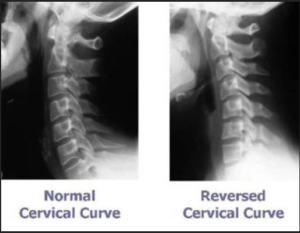
When I was born, the doctor used forceps for my delivery. My mom told me that I had two very large bruises on my head where the clamped down and pulled. Later, I found out that I also had a hard time breathing the first few minutes of my life—note: the respiratory centers are located at the brainstem, the area that was twisted and turned violently during my birth. I truly believe that the instability in my neck and upper cervical spine was directly related to my very first day on earth.
My journey as a chiropractic assistant, a massage therapist and now a chiropractor has truly given me pause on what my neck and spine would look like today, at age 48, if I had never known about corrective chiropractic care.
Phases of Spinal Degeneration
As a child I was very active, left the house early in the morning to go play outside, only came home when hungry and only when the streetlights came on. Needless to say, I had many a bump and bruise that unknowingly added to the trauma sustained at birth. Now, young children typically don’t have or complain of severe pain, so it’s difficult to determine how much of my ruff and tumble years contributed to my severe pain in my teens, however, only 10% of our nerve fibers are allocated to pain, so the older I got, the more the injuries piled on.
By the time I was 18 and had my very first chiropractic exam, I was already in Phase I of degenerative change. Degeneration of the spine is progressive in nature and will continue unless an intervention is applied. I’m so grateful that the intervention was chiropractic. Look at the picture below to see how these phases progress if not taken care of:
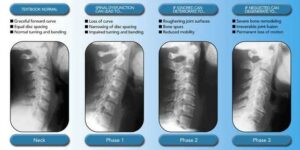
Wolff’s Law
So, why do these changes take place? It’s based on a law of physics called Wolff’s Law. In 1892, Dr. Wolff’s theory about bone transformation was published. One hundred years later, bone remodeling is now a medical fact!
Wolff’s Law states that bone will adapt to the load or stress placed upon it. This means that increased loading of bone tissue will promote increased density. This is why many individuals with osteopenia or osteoporosis utilize resistance training to stimulate bone growth. However, when the stress or load on the bone is abnormally loaded, Wolff’s Law can contribute to the progression of spinal degeneration.
A common misconception about spinal degeneration is that it is a normal age-related process. This would mean that most people would exhibit the same level of degeneration at roughly the same age. The truth is that spinal degeneration progresses with time but is not necessarily a normal aging process. There are other factors influencing the progression of spinal degeneration.
In the spine, a similar process plays out with spinal degeneration. As abnormal pressure builds up on the segments of the spine, the increased demand requires more support. The wear and tear associated with increased stress around the joints of the spine will stimulate bone cells to produce hardened tissue to help support the abnormal load. This makes the spine more rigid, and spinal degeneration begins to advance.
How does this process start in the average person? Typically there is a physical trauma that starts the process (remember my initial trauma at birth?). This may be a whiplash injury, car accidents, poor posture, or a jarring force to the neck and spine. This jarring force will cause the alignment of the spine to be compromised. Without proper alignment, the spine cannot move properly, and abnormal stress begins to build. These are very common occurrences so it makes spinal degeneration a very common finding as we age, but IT’S NOT NORMAL.
Without this normal lordosis (proper spinal curve in the neck), most often the balance of the weight of the head is tilted forward and thus creates increased wear and tear on the intervertebral discs and the vertebral bodies. This eventually leads to bony spurs and osteophytes. Such changes also lead to decreased mobility of the cervical spine and to cervical pain.” From Springfield, Missouri’s very own pain expert, Dr. Norman Shealy (MD / Ph.D) from an article he wrote for Practical Pain Management back in April of 2009 (Restoration of Normal Cervical Curves).
What are the symptoms of spinal degeneration?
Spinal degeneration develops very slowly over a period of many years. Unfortunately, in the early stages of spinal degeneration, symptoms are very mild and infrequent, which means that many individuals are developing spinal degeneration without any clear indication that their spine is degenerating.
The symptoms of degeneration occur in several stages depending on the severity of its progression. In the early stages, symptoms include:
- Spinal stiffness that improves with activity
- Decreased mobility of the spine
- Intermittent sharp pain
In the more advanced stages of cervical spondylosis, symptoms include:
- Significant decrease in spinal range of motion
- Swelling around the joints of the spine
- Pain that is worse in the morning
- Pinched nerves (numbness/tingling in arms, hands)
- “Grating” sensation when moving the neck or spine
It is important to remember that symptoms alone are a poor indicator of how spinal degeneration is progressing as some may not have any symptoms at all!
“Degenerative changes of the cervical spine are commonly accompanied by a reduction or loss of the segmental or global lordosis, and are often considered to be a cause of neck pain. Nonetheless, such changes may also remain clinically silent.” The opening sentences of a study called The Association Between Cervical Spine Curvature and Neck Pain from the May 2007 issue of The European Spine Journal
How does spinal degeneration start?
How does this process start in the average person? Typically there’s a physical trauma that starts the process. This may be a whiplash injury, car accidents, poor posture, or a jarring force to the neck and spine. This jarring force will cause the alignment of the spine to be compromised. Without proper alignment, the spine cannot move properly, and abnormal stress begins to build.
Upper cervical misalignment is a common underlying cause of spinal degeneration. This occurs when the alignment of the upper spine becomes compromised, shifting the weight of the head away from its center of gravity. As the weight of the head weighs down on the neck and spine, spinal degeneration will slowly begin to develop. https://pubmed.ncbi.nlm.nih.gov/11562150/
The most common causes of spinal degeneration in adults include:
- Car accidents
- Sports injuries
- Slips and falls
- Poor posture/ergonomics (forward head posture)
- Weak neck muscles
- Spinal misalignment
Even though these are the most common causes that lead to spinal degeneration in adults, remember, these injuries to the spine typically occur early in life as well. If they aren’t addressed at the time of the injury, it leads to the imbalance that causes the degenerative process to begin.
Looking at that list above, I had my fair share of almost everything on that list BEFORE the age of 18 and they don’t even list my very first injury AT BIRTH!
How do we determine whether or not spinal degeneration is the CAUSE of your pain?
An accurate diagnosis of cervical spondylosis can only be reached by acquiring imaging of the cervical spine. Several forms of imaging may be used to identify areas of spinal degeneration, including:
- X-ray
- UpRight MRI
- CTscan
The most common and in-house imaging is X-ray, however, should we not see symptoms improve at least 50% within the first 4-6 weeks, we will recommend further imaging, especially MRI. These tests will reveal the segments of the spine that are involved, the severity of spinal degeneration, and the underlying alignment issues. As a corrective, upper cervical specific chiropractic care facility, we take very precise views that will determine not only the areas of misalignment and instability, but EXACTLY how to adjust you using specific vectors to personalize your care.
Not all chiropractic approaches are created equally. Patients with spinal degeneration should seek out upper cervical chiropractors because of the unique nature of their evaluation and management. These doctors can perform precise, effective and gentle adjustments without irritating areas of spinal degeneration, risking injury, or twisting, popping, or cracking the spine.
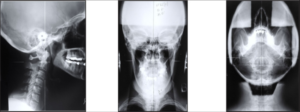
Additional testing may include:
- Paraspinal thermography to determine nerve function to the autonomic nervous system (organs and glands)
- Surface Electromylograph (sEMG) to determine function of the motor nervous system (muscles and balance)
- Heart Rate Variability (HRV) to determine the stress spinal misalignment may be causing (chemical, physical and emotional stressors)
- Postural evaluation
- Muscle and joint palpation
- Range of motion and orthopedic testing

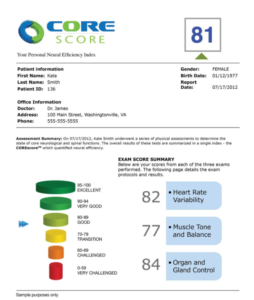
Pic
I’m so grateful that I came across corrective, upper cervical chiropractic care. Through my studies, I am confident that if I never was introduced to this gentle and effective care, my life would look very different right now. We see it everyday at HealthWorks. More and more medications, steroid injections and surgeries with very little or only temporary relief.
Unfortunately, many of you who have been living on the medical merry-go-round understand this all too well. While none of this could be considered “new” information, it is information that is almost universally ignored by the practicing medical community. It’s another one of those areas where the gap between the way that physicians are treating patients in their clinics, and the discoveries that researchers are making in their labs, could be as wide as the Grand Canyon!
Why does HealthWorks pay special attention to the neck when spinal degeneration and pain can occur throughout?
It was Dr. Rene Calliet’s 1987 book Rejuvenation Strategy that stated, “Most attempts to correct posture are directed toward the spine, shoulders and pelvis. All are important, but, head position takes precedence over all others. The body follows the head. Therefore, the entire body is best aligned by first restoring proper functional alignment to the head“. Dr. Calliet was the Director of Physical Medicine and Rehabilitation at USC’s School of Medicine at the time he wrote this.
Think of the spine as a train with the upper cervical spine (C1/C2, atlas/axis) as the engineer to the entire train. Then the neck is the engine and the low back/pelvis the caboose! What happens when the engineer takes the train off the track? Right! The ENTIRE train goes off the track. If just the atlas (C1) is out of alignment this is what happens to your ENTIRE SPINE!
DOES THIS LOOK LIKE YOU???
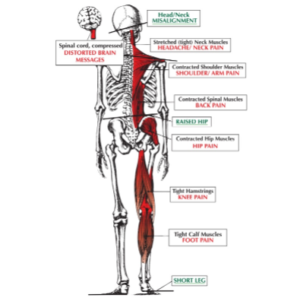
Well, this doesn’t need to be you!
Our promise to you
HealthWorks is dedicated to comprehensive and specific approach to taking care of spinal and nervous system needs. Let us help you and your teen find out how taking care of the most important system in the body will create optimal health that will last a lifetime! Remember, I’ve been where you have been. I have seen and felt the difference gentle, corrective, upper cervical specific chiropractic care has made in my life. I really hope the same for you and your family. Don’t grow old fast, but beat the causes of spinal degeneration and pain today!
References:
- Kumaresan S, Yoganandan N, Pintar FA, Maiman DJ, Goel VK. Contribution of disc degeneration to osteophyte formation in the cervical spine: a biomechanical investigation. J Orthop Res. 2001 Sep;19(5):977-84. doi: 10.1016/S0736-0266(01)00010-9. PMID: 11562150.
- From Springfield, Missouri’s very own pain expert, Dr. Norman Shealy (MD / Ph.D) from an article he wrote for Practical Pain Management back in April of 2009 (Restoration of Normal Cervical Curves
- The opening sentences of a study called The Association Between Cervical Spine Curvature and Neck Pain from the May 2007 issue of The European Spine Journal
- Dr. Rene Calliet’s 1987 book Rejuvenation Strategy

